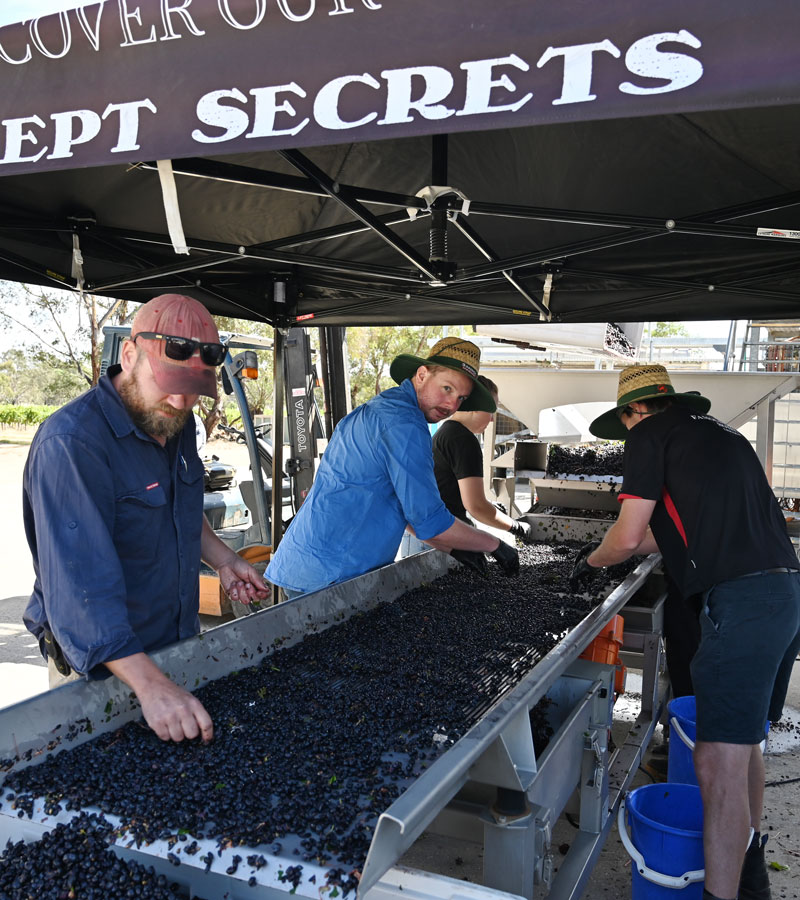Pinot Meunier vs Pinot Noir

Pinot Meunier is wine’s version of the third member of that 1980s pop band whose name no one can remember. Closely related to Pinot Noir – it’s a mutation from cloning. The red grape’s main claim to fame is that it’s the third grape variety allowed in Champagne, alongside Chardonnay and Pinot Noir. It’s also one of the oldest grape varieties growing at Best’s Wines. With a 1.2-hectare vineyard first planted in 1868. And like many of the more than 40 varieties of grapes planted at Best’s. Pinot Meunier also came with a plot twist, that only emerged more than a century later. More on that shortly.
When people come to visit us at our cellar door in Great Western, one of the questions I’m most often asked is “What’s the difference between Pinot Meunier and Pinot Noir?”. So, I thought I’d tell you a little bit more about this lesser-known member of the Pinot family.
The irony for a grape that stars so prominently in Champagne (it’s the region’s most widely planted variety) is that Pinot Meunier is really just a reliable workhorse for winemakers. It can boldly grow where no vine has gone before! Its superpower is that it suits sites where it’s too cold for Chardonnay and Pinot Noir. Pinot Meunier ripens sooner, it’s can be an insurance policy grape during hard vintages.
Perhaps that’s what Henry Best had in mind when he planted the vines along the Concongella Creek just a year before Best’s began producing its first vintage. It is the red grape we pick earliest every year. At Best’s we have the oldest Pinot Meunier vines in the world. Wine critic James Halliday calls the resulting wine “liquid history”.
The Start of Miller’s Burgundy
Meunier, incidentally, is French for ‘miller’. A name derived from the appearance of the bottom of the leaf. The underside of the leaf is white and thus looks like it’s been dipped in flour. For a long time, the team at Best’s called it Miller’s Burgundy. Blended with other grapes, it helps soften the palate, but Pinot Meunier also has its own distinct flavours. It has a lot of similar flavours and aromas to its sibling, Pinot Noir, but has higher acidity with more citrus characters and lighter, less earthy profile. It can also display slightly cigar-smoky flavours. But the surprising thing for such a prevalent grape is how rarely it’s bottled as a single varietal.
Best’s is one of the few wineries in the world to produce a pure Pinot Meunier. And that’s a relatively new phenomenon. According to my father’s memory and our records, Pinot Meunier was not produced as a varietal until 1967. Just as those vines were turning 100 years old. We called those early bottlings Miller’s Burgundy.
Pinot Meunier five decades on
Five decades on, I still remember that big ’67 crop and suggesting to my father that we make a straight varietal. Because the public interest in table wines from Australia was just beginning to emerge. And I have a confession: back then, we were quite unaware that Pinot Meunier was one of three classic varieties of Champagne.
Despite an accepted wisdom – not by us – that Pinot Meunier did not age well, that 1967 Miller’s Burgundy is arguably one of the best red wines we have in our cellar today. Our most recent vintage, the 2022, has at least a 20-year drinking window. A decade after I became part of the third generation of the Thomson family to work the vintages at Best’s, we planted another acre (0.6 hectare) of Pinot Meunier in 1971.
A Surprise in Store, a Century on
Now, back to the original 1868 planting. We learnt something interesting about it in the 1970s, thanks to ampelography. The vineyard had 85% rough leaf and 15% smooth leaf vines. It turned out those smooth-leaved ones were actually Pinot Noir.
Incidentally, the CSIRO, via its Cooperative Research Centre for Viticulture, discovered the truth about Pinot Meunier’s origins. Concluding that the mutation meant it didn’t respond to a certain growth hormone. Meaning the change was only in what they called the ‘epidermal’ cell layer – the outermost one. Making it a chimera, which deep down, remains at its core Pinot Noir.
Over the last 50 years, we’ve focused on highlighting the unique qualities of this grape. We changed the name from Miller’s Burgundy to Best’s Pinot Meunier in the early 70s. Since 1977, included grapes from the ’71 vines on some occasion. For five years from the mid-80s, we combined it in a 60/40 blend using Pinot Noir from a small parcel we planted in 1980, and a larger 1.8-hectare vineyard planted in 1987. A little over 20% of that second planting (0.41hectare) was taken from the 15% in the original 1868 block. The wine we make from them is now called Best’s Old Clone Pinot Noir.
A decade passed before we decided the grapes from the 1980 planting were good enough to stand on their own feet. Our first straight Pinot Noir arrived in 1991. This wine is now made from a combination of the 1980 and ‘87 vineyards. At the same time, we went back to making Pinot Meunier – the ‘Old Vine’ version from those original 1868 plantings. But only when we decide the vintage is good enough – and the ‘Young Vine’ from the ’71 block (with the 1868 added in when we don’t make the Old Vine).
A Cult Classic
I’m pleased to see the Old Vine Pinot Meunier has become something of a cult wine. We put a lot of effort into making it, hand-picking and sorting the grapes. Then fermenting them in small open fermenters before maturation in French oak. We’re so proud of it that it is part of the Best’s Icon Range alongside our other flagship wines, the Thomson Family Shiraz, and Bin No. 0 Shiraz.
And as I said earlier, the common wisdom was that Pinot Meunier didn’t age, but I think we’ve proven them wrong! Best’s winemakers Justin Purser and Jacob Parton build the Old Vine for a 20-years plus lifespan to reveal the additional complexity in this fascinating grape varietal.
Perhaps my favourite compliment for the Old Vine Pinot Meunier came from James Halliday when he tried the 2017. James said that among the 70-plus wines he tastes every day for the Wine Companion, “I plead guilty” to swallowing this one during his tastings. “Its length is prodigious, its scented bouquet a siren call, the palate silk,” Halliday wrote. I raise my glass of Pinot Meunier to that.
One of our ‘Best Kept Secrets’
Read Jeni’s description of the 2022 Old Vine Pinot Meunier
Old vines don’t describe the half of it. Best’s vines were planted in 1868 which makes them among the oldest Pinot Meunier vines in the world. It is a point to ponder as you explore, the myriad aromas and flavours of this wine. A free-wheeling, sustained ride of pure vinous pleasure. Bright purple-garnet hues.
Combines youthful freshness and vitality with real depth of concentrated flavour. Old vines off a single vineyard site seen to be able to achieve that kind of effortless feat so easily. Cherry, pomegranate, raspberry, dried herbs and a ribbon of pepper and earthy spice mingle, bright and easy flowing, with superfine tannins and gentle oak.
The palate comes alive with complexity of fruit, yet it’s so, so young. This is the great secret to this wine, year in year out. It arrives fully formed and ready to be enjoyed upon release. And yet, rest assured, it will age an absolute treat. It is a national treasure.
Winepilot – Jeni Port, June 2023 Drink now to 2038. Rating: 95 points





